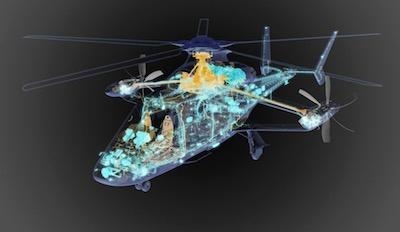Thu, Oct 18, 2018
Aircraft Funded By The European Union’s H2020 Framework Through The Clean Sky 2 Program
Airbus Helicopters continues to progress with the development of its Racer (Rapid And Cost-Efficient Rotorcraft) technology demonstrator, funded by European Union’s H2020 framework through the Clean Sky 2 program, and aiming to provide the best trade-off between speed, cost-efficiency, sustainability and mission performance.

After the validation of the demonstrator’s aerodynamic configuration last year, key subsystems have now successfully passed their preliminary design review (PDR) giving way to the launching of first components manufacture. Final assembly of the prototype is planned to start in Q4 2019.
“I want to thank all of our European partners for the excellence of their work and for their commitment in this fantastic project”, said Tomasz Krysinski, Head of Research & Innovation at Airbus Helicopters. “The PDR marks a major achievement for the Racer program as it allows to freeze interfaces and 3D definitions of the main subsystems, prior to detailed design and manufacture of key components.”
Long-lead items are the first ones to be manufactured. Airbus Helicopters teams already launched production of the lateral drive shaft, one of the Racer’s most innovative components. Among key subsystems, Italy’s Avio Aero, a GE Aviation Business, is launching procurement and manufacturing for the aircraft’s lateral gear boxes housing, while Hamble UK based GE Aviation Integrated Systems is taking care of the wing’s titanium cradle part. Romania’s INCAS/Romaero has already started manufacturing the Racer’s composite side panel and Spain’s Aernnova the tail parts primary structure.
Together with its partners, Airbus Helicopters is currently refining the content of the future Racer flight demonstration in Clean Sky 2 which will begin in 2020 and include about 200 flight hours. The first part will focus on the progressive opening of the flight envelope and on assessing key performance objectives as well as speed, handling qualities, stability and aerodynamics. The second phase will aim at demonstrating the aircraft’s suitability to carry out potential missions where increased speed and efficiency would bring significant added value, such as emergency medical services (EMS), search & rescue (SAR) and private transport. This second flight testing phase will also allow to mature low-noise flight procedures, unique to the Racer demonstrator formula.
(Image provided with Airbus news release)
More News
LinxUs System Adds Capabilities for Data-Driven Operators Textron Aviation announced another option for operators processing their post-flight data, adding interoperability with GE>[...]
Aero Linx: The de Havilland Moth Club Ltd The de Havilland Moth Club evolved from a belief that an association of owners and operators of Moth aeroplanes should be formed to create>[...]
(Pilot) Inadvertently Applied Excessive Braking Action, And The Airplane Nosed Over Analysis: The pilot reported that, while landing at a remote, rough and uneven airstrip in a tai>[...]
“MCADT is committed to rapidly integrating armed first-person view drones into the FMF, enhancing small-unit lethality and providing organic capabilities that warfighters cur>[...]
From 2017 (YouTube Edition): Major Engine Supplier Joins Forces With Small Aircraft Manufacturer… GE recently made an agreement with Venom Aircraft to supply engines for the>[...]
 Citation Operators Get Another Flight Data Connection for QA
Citation Operators Get Another Flight Data Connection for QA ANN's Daily Aero-Linx (06.01.25)
ANN's Daily Aero-Linx (06.01.25) NTSB Final Report: Bellanca 8GCBC
NTSB Final Report: Bellanca 8GCBC Aero-News: Quote of the Day (06.01.25)
Aero-News: Quote of the Day (06.01.25) Classic Aero-TV: High-Speed Match-up - Venom and GE Rebirth A Legend
Classic Aero-TV: High-Speed Match-up - Venom and GE Rebirth A Legend



